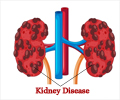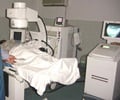Nephrogenic systemic fibrosis (NSF) is a newly identified debilitating and painful condition that affects patients with kidney failure and is characterized by a thickening and hardening of the skin.
Nephrogenic systemic fibrosis (NSF) is a newly identified debilitating and painful condition that affects patients with kidney failure and is characterized by a thickening and hardening of the skin. It usually affects the arms and legs but it can also affect internal organs and can progress so rapidly that patients can be immobilized and wheelchair-bound within a few weeks. Although it is not clear what causes NSF, the condition has been linked to gadolinium, a contrast agent used in MRI scans.
A new study published in the October issue of Arthritis & Rheumatism on the prevalence of NSF and its risk factors found that the disease is associated with an increased risk of dying and that gadolinium exposure is a significant risk factor for developing it.Led by Jonathan Kay of the Massachusetts General Hospital in Boston, MA, Derrick J. Todd, Anna Kagan, and Lori B. Chibnik conducted a study on patients undergoing dialysis at six outpatient centers in the Boston area. They used a simple three-part skin examination to check for the three skin changes associated with NSF: hyperpigmentation (darkening of the skin), hardening and tethering (thickening). Patients with two out of the three findings were considered to have a positive examination for NSF and their death rates were followed for two years following the exam. The researchers chose a noninvasive skin examination in order to maximize participation and minimize the complications sometimes seen when these patients undergo surgical procedures such as biopsies. In addition, using electronic medical records, patients who had undergone scans with gadolinium-containing contrast agents were also identified and their records were examined to confirm when the exposure took place.
The results showed that of 186 patients, 25 had skin changes consistent with NSF. A total of 25 patients (24 percent) died within two years of the skin examination; those with NSF had a mortality rate of 48 percent compared with 20 percent for those who did not have skin changes consistent with NSF. Patients who had been exposed to gadolinium were almost 15 times as likely to develop NSF skin changes: among the 90 patients with electronic records, 54 had been exposed to gadolinium and 30 percent of these developed NSF compared to only 1 percent of the 36 patients who had not been exposed to gadolinium. Conversely, 94 percent of the 17 patients who developed NSF changes had previously been exposed to gadolinium, compared with 52 percent who did not develop skin changes.
This is the first study to establish the prevalence of NSF-related skin changes in patients undergoing dialysis and the first to quantify the association between NSF skin changes and exposure to gadolinium. Because NSF is a newly reported condition, skin biopsies were available for only five patients and in each of these cases the diagnosis of NSF was confirmed. “The paucity of available skin biopsy specimens highlights that NSF is likely under recognized by many practicing physicians,” the researchers state. They also note that the increased risk of death in patients with NSF skin changes largely occurred within the first six months following their examation, suggesting an increased risk of early mortality.
Although additional studies are needed to determine why patients with kidney disease risk developing NSF after exposure to gadolinium, the researchers conclude that contrast agents containing this element should be used only with extreme caution in patients with chronic kidney disease and that, if they are exposed to gadolinium, these patients should subsequently receive regular careful skin examinations. They conclude: “The identification of larger numbers of patients with NSF will allow further investigations into the pathogenesis, treatment, and prevention of this recently described debilitating, and potentially fatal, condition.”
In an accompanying editorial in the same issue, Shawn E. Cowper, Phillip H. Kuo and Richard Bucala of Yale University School of Medicine in New Haven, CT, point out that reported cases of NSF have led to a Public Health Advisory urging caution in the use of MRI scans for patients with kidney disease and prompt dialysis in those who have undergone scans involving gadolinium. They note that the study by Todd and colleagues contributes to this evolving story, and that the evidence of early skin changes seen in the study raises the possibility that such changes are more common than was previously thought and may point to an early or less severe form of NSF. Many questions remain about the origins of NSF (including why some patients exposed to gadolinium develop the disease and others do not) and they suggest that studying how cells respond to gadolinium exposure will shed light on this disease. They conclude: “Such information also could facilitate the development of MR contrast agents that have a less toxic response profile, and preserve the high clinical utility of contrast-enhanced MR as an imaging modality in patients with renal insufficiency.”
VEN/C











